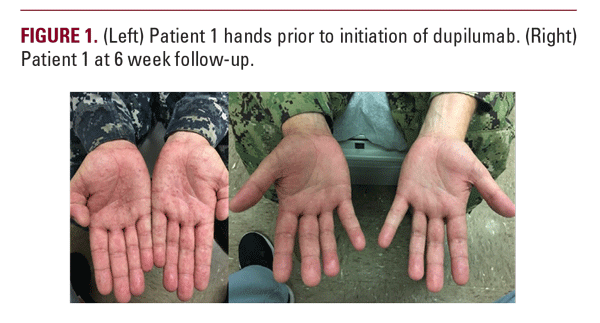INTRODUCTION
Dyshidrotic eczema, also known as dyshidrosis or pompholyx when involving larger bullae, is a chronic, relapsing palmoplantar dermatosis characterized by intensely pruritic and frequently painful deep-seated vesicles and bullae. Often likened to tapioca pudding, the vesicles typically erupt on the lateral aspects of the fingers and persist for several weeks before progressing to desiccation and desquamation.1 Perpetual cycles of relapse and remission frequently last several years and recurrence is common.
Rather than an independent disease entity, dyshidrotic eczema is often thought to be a manifestation of other eczematous dermatosis such as atopic dermatitis or contact dermatitis (allergic and irritant).2,3 Factors thought to be associated with the development of dyshidrotic eczema include a history of atopic dermatitis,4 a history of allergic contact dermatitis,4-6 exposure to contact irritants,7 id reactions,8 IVIG exposure,6,8,9 hyperhidrosis,4 smoking,5-7 and sunlight exposure.10
Basic treatment strategies for all patients with dyshidrotic eczema include avoidance of contact irritants, gentle skin care to reduce irritation, and use of emollients to restore barrier function.11 Mild to moderate cases may be treated with topical steroids, calcineurin inhibitors, and ultraviolet light (narrow band UV-B and UVA1). Treatment failure with first line topical agents is common, and more potent treatments such ultra-high potency topical corticosteroids under occlusion, systemic corticosteroids, psoralen-ultraviolet A therapy (PUVA), and systemic immunosuppressants such as methotrexate, mycophenolate mofetil, cyclosporine, and azathioprine are often used. Unfortunately, many cases of dyshidrotic eczema are recalcitrant to multiple treatment trials, resulting in significant morbidity. In this series, we discuss two cases of recalcitrant dyshidrotic eczema that had profound improvement after treatment with dupilumab.
Rather than an independent disease entity, dyshidrotic eczema is often thought to be a manifestation of other eczematous dermatosis such as atopic dermatitis or contact dermatitis (allergic and irritant).2,3 Factors thought to be associated with the development of dyshidrotic eczema include a history of atopic dermatitis,4 a history of allergic contact dermatitis,4-6 exposure to contact irritants,7 id reactions,8 IVIG exposure,6,8,9 hyperhidrosis,4 smoking,5-7 and sunlight exposure.10
Basic treatment strategies for all patients with dyshidrotic eczema include avoidance of contact irritants, gentle skin care to reduce irritation, and use of emollients to restore barrier function.11 Mild to moderate cases may be treated with topical steroids, calcineurin inhibitors, and ultraviolet light (narrow band UV-B and UVA1). Treatment failure with first line topical agents is common, and more potent treatments such ultra-high potency topical corticosteroids under occlusion, systemic corticosteroids, psoralen-ultraviolet A therapy (PUVA), and systemic immunosuppressants such as methotrexate, mycophenolate mofetil, cyclosporine, and azathioprine are often used. Unfortunately, many cases of dyshidrotic eczema are recalcitrant to multiple treatment trials, resulting in significant morbidity. In this series, we discuss two cases of recalcitrant dyshidrotic eczema that had profound improvement after treatment with dupilumab.
CASE 1
A 38-year-old male Chief Petty Officer in the United States Navy presented to the Dermatology Clinic with a five-year history of firm, intensely pruritic vesicles on his hands and feet. He had been previously treated with keratolytic agents, topical clobetasol, PUVA, and acitretin without significant improvement of symptoms. Biopsy of the palm demonstrated spongiotic dermatitis with intraepidermal vesicle formation supporting the diagnosis of dyshidrotic eczema. Patch testing showed reactions to benzocaine, nickel sulfate, methylisothiazolinone, iodoproponyl butylcarbamate, cocamidopropyl betaine, and formaldehyde. Despite avoidance and adherence to a low nickel diet, he only had mild improvement of symptoms. He continued to report a sensation akin to “constantly walking on Legos.†Treatment with 60mg of intramuscular triamcinolone led to complete resolution of symptoms, but recurrence occurred within 1 month. He was started on dupilumab 600mg subcutaneously (SQ) followed by 300mg SQ every other week with clobetasol as needed. At follow up, he noted rapid and profound improvement beginning within 1 week of his first dose. At 6 months, improvement was sustained without
application of clobetasol.

application of clobetasol.

CASE 2
A 38-year-old male Culinary Specialist in the United States Navy was evaluated in the dermatology clinic for a several-year history of dyshidrotic eczema of the hands and feet. His symptoms had previously been mild and were managed only with topical moisturizers. However, within the past year, his symptoms began to worsen significantly, to the extent that they interfered with his ability to cook and made walking difficult. Since the worsening of his symptoms, he has not responded to topical corticosteroids. He did experience some improvement with oral prednisone, with symptoms returning to baseline






